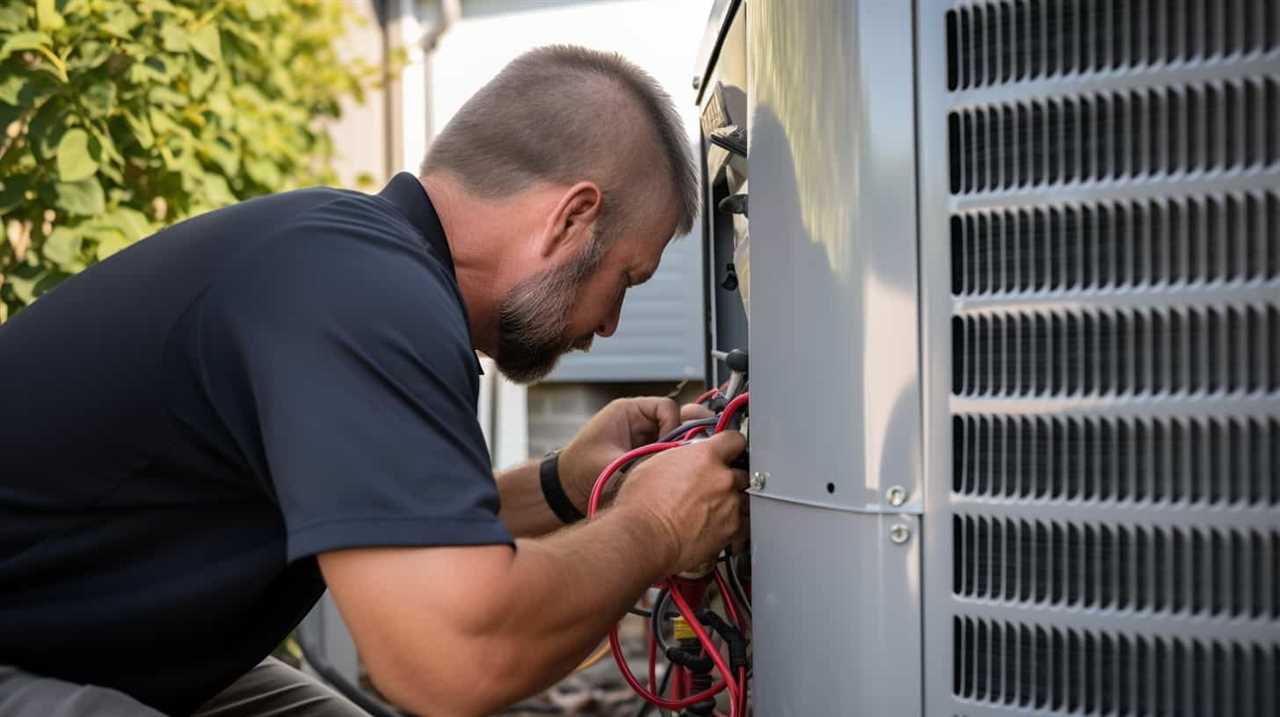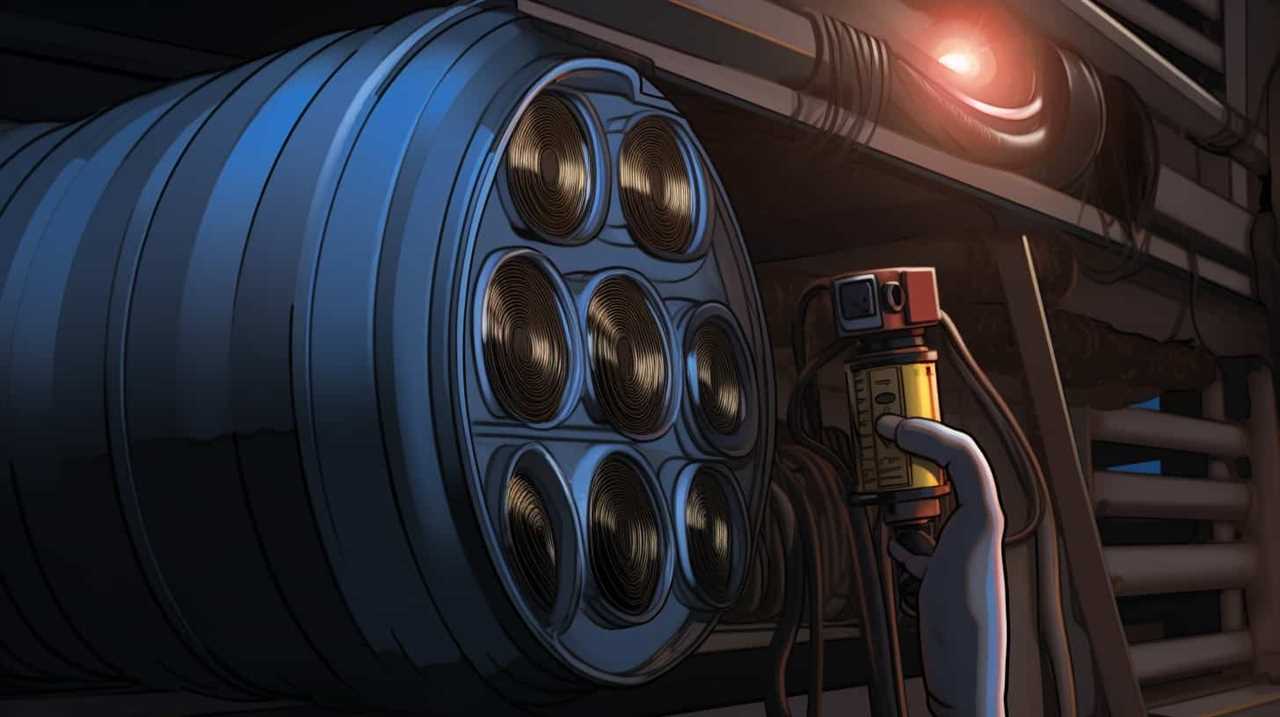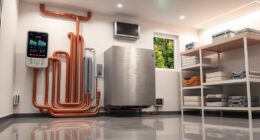We have identified the essential factors for enhancing the energy efficiency of heat pumps. Through the adoption of routine maintenance, ideal temperature adjustments, and transitioning to models with high efficiency, we are able to optimize the functionality of these units.
Additionally, insulating our homes, utilizing smart thermostats, and incorporating renewable energy sources like solar and geothermal power can further amplify their efficiency.
Join us as we delve into the secrets of optimizing heat pump energy efficiency and serving the environment while saving on costs.
Key Takeaways
- Regular maintenance and upgrading to a high-efficiency heat pump are essential for maximizing energy efficiency and performance.
- Optimal temperature settings and utilizing smart thermostats can significantly reduce energy consumption and optimize heat pump energy efficiency.
- Insulating your home and maximizing airflow with proper ventilation techniques are crucial for improving energy efficiency.
- Using programmable timers and harnessing solar energy can further enhance heat pump operation and reduce energy consumption.
The Importance of Regular Maintenance
Regular maintenance is essential for maximizing the energy efficiency of our heat pump system. Adhering to an optimal maintenance schedule ensures that our system operates at peak performance, resulting in significant benefits for both our energy consumption and overall comfort.

By scheduling professional inspections, we can identify and address any potential issues before they escalate, saving us from costly repairs and unnecessary energy waste. These inspections allow us to optimize the system’s efficiency by cleaning or replacing filters, checking refrigerant levels, and ensuring proper airflow.
Additionally, professional technicians can calibrate our system to ensure it operates within manufacturer specifications, further enhancing its energy efficiency. Regular maintenance not only extends the lifespan of our heat pump but also minimizes our environmental impact, making it a responsible choice for those who value sustainability and efficient resource utilization.
Optimal Temperature Settings
We can optimize energy efficiency by setting our heat pump to a temperature range between 68 and 72 degrees Fahrenheit. Maintaining this smart temperature control can significantly reduce energy consumption and save on heating costs.
Here are some energy-saving tips for setting the optimal temperature:

-
Programmable Thermostat: Invest in a programmable thermostat that allows you to set different temperatures for different times of the day. This way, you can lower the temperature when you’re away or sleeping, and raise it when you’re at home and active.
-
Zoning: Consider implementing a zoning system that allows you to control the temperature in different areas of your home independently. This way, you can heat only the occupied spaces, reducing energy wastage.
Upgrading to a High-Efficiency Heat Pump
When considering upgrading to a high-efficiency heat pump, there are two important factors to consider: cost versus savings and installation and maintenance.
We need to carefully evaluate the initial cost of the high-efficiency heat pump and compare it to the potential long-term energy savings it can provide.

Additionally, the installation and maintenance requirements of the new heat pump must be taken into account to ensure optimal performance and efficiency.
Cost Vs. Savings
Let’s explore the cost vs. savings of upgrading to a high-efficiency heat pump. When considering whether to upgrade your heat pump, conducting a thorough cost analysis is essential.
Here are two key factors to consider:
-
Initial Investment: Upgrading to a high-efficiency heat pump may require a higher upfront cost compared to a standard model. However, this initial investment can be offset by long-term energy savings and lower utility bills.

-
Energy Consumption: High-efficiency heat pumps are designed to consume less energy while providing the same level of heating or cooling. This reduction in energy consumption translates into significant cost savings over time, especially in regions with high energy prices.
Installation and Maintenance
By properly installing and regularly maintaining a high-efficiency heat pump, we can maximize its energy efficiency and performance. When it comes to installation, there are several best practices to follow. First, ensure that the heat pump is sized correctly for the space it will be heating or cooling. Oversized or undersized units can lead to inefficiency and discomfort. Next, proper placement of the outdoor unit is crucial to optimize airflow and minimize noise. Additionally, ensuring a tight seal around all ductwork and connections will prevent air leakage and maintain efficiency. Regular maintenance is also essential to keep the heat pump operating at its best. This includes cleaning or replacing air filters, inspecting and cleaning coils, and checking refrigerant levels. By following these installation best practices and troubleshooting common issues, we can ensure that our high-efficiency heat pump performs optimally, saving energy and serving us effectively.
| Installation Best Practices | Troubleshooting Common Issues | Maintenance Tips |
|---|---|---|
| Proper sizing | Inadequate heating/cooling | Clean/replace filters regularly |
| Correct outdoor unit placement | Insufficient airflow | Inspect and clean coils |
| Tight seal around ductwork and connections | Refrigerant leaks | Check refrigerant levels |
| Excessive noise | Schedule annual professional maintenance | |
| Inefficient operation | Monitor energy consumption |
Insulating Your Home
To maximize heat pump energy efficiency, we can start by insulating our homes. Proper insulation techniques and the use of energy-saving materials play a crucial role in reducing heat loss and improving overall energy efficiency.
Here are two key strategies to consider:

- Insulation Techniques:
- Wall Insulation: Adding insulation to exterior walls can significantly reduce heat transfer and improve thermal performance.
- Attic Insulation: Insulating the attic helps prevent heat loss through the roof and ensures a more comfortable indoor environment.
- Energy Saving Materials:
- Insulation Boards: Installing rigid insulation boards can provide an extra layer of thermal protection.
- Weatherstripping: Applying weatherstripping to doors and windows minimizes air leakage, enhancing insulation effectiveness.
Utilizing Smart Thermostats
The smart thermostats provide us with an opportunity to optimize our heat pump energy efficiency by allowing us to easily control and schedule temperature settings in our homes. By utilizing smart thermostats, we can enjoy several benefits that lead to significant energy savings.
These thermostats use advanced algorithms and sensors to learn our preferences and adjust the temperature accordingly, ensuring that we only use energy when necessary. Additionally, smart thermostats can be controlled remotely through smartphone apps, enabling us to make adjustments even when we’re away from home.
This level of control and convenience allows us to maximize energy efficiency and reduce wasted energy, resulting in cost savings and a reduced environmental impact.
Now, let’s explore how maximizing airflow with proper ventilation can further enhance our heat pump energy efficiency.

Maximizing Airflow With Proper Ventilation
When it comes to maximizing airflow with proper ventilation, there are three key points to consider:
-
Clean filters: Clean filters are crucial for maintaining efficient airflow and preventing dirt and debris from clogging the system.
-
Optimal duct placement: Proper duct placement ensures that air can flow freely and reach all areas of the space.
-
Balancing airflow distribution: Balancing airflow distribution ensures that each room receives the appropriate amount of conditioned air.

Importance of Clean Filters
Our filters play a crucial role in maintaining optimal airflow and maximizing the energy efficiency of our heat pumps. To ensure the filters are performing at their best, regular cleaning and maintenance are essential.
Here are some key points to consider when it comes to filter maintenance:
-
Cleaning frequency: It’s recommended to clean the filters every 1 to 3 months, depending on the level of dust and pollutants in the environment. Regular cleaning prevents the accumulation of debris and ensures unrestricted airflow.
-
Proper cleaning techniques: Filters should be cleaned using gentle methods such as vacuuming or rinsing with water. Harsh cleaning methods can damage the filters and reduce their effectiveness.

-
Replacement: Filters should be replaced annually or as recommended by the manufacturer. Over time, filters can become clogged and lose their ability to filter out particles effectively.
Optimal Duct Placement
To maximize airflow and ensure proper ventilation, we need to consider optimal duct placement. The placement of ducts in a heating or cooling system is crucial for its efficiency and effectiveness. One key factor to consider is optimal duct insulation, which helps prevent heat loss or gain during air transfer. Proper insulation minimizes energy waste and ensures that conditioned air reaches its intended destination without significant temperature variations. Another crucial aspect is ductwork design, which determines the layout and configuration of the ducts. A well-designed ductwork system minimizes air leaks, reduces pressure drops, and maximizes airflow. By carefully considering both optimal duct insulation and ductwork design, we can achieve better energy efficiency and provide optimal comfort to those we serve.
| Key Factors | Benefits |
|---|---|
| Optimal Duct Insulation | – Prevents heat loss/gain |
| – Reduces energy waste | |
| – Maintains consistent temperature | |
| Ductwork Design | – Minimizes air leaks |
| – Reduces pressure drops | |
| – Maximizes airflow |
Balancing Airflow Distribution
We must ensure proper airflow distribution and maximize airflow through proper ventilation techniques. Balancing air circulation is crucial for optimizing the performance of heat pumps and increasing energy efficiency. To achieve this, we need to consider the following:
-
Duct design: Properly designed ductwork ensures that air is evenly distributed throughout the space. This involves determining the appropriate size and placement of ducts to minimize resistance and pressure drops.

-
Zoning: Implementing zoning systems allows for customized temperature control in different areas of a building. By dividing the space into zones and adjusting airflow accordingly, energy consumption can be reduced.
In addition to balancing air circulation, optimizing fan speed is also important. The fan speed should be set to deliver the necessary airflow without excessive energy consumption. By finding the right balance, we can maximize the efficiency of heat pump systems and provide optimal comfort while minimizing energy usage.
Using Programmable Timers
Using programmable timers can significantly increase the energy efficiency of heat pumps. By allowing users to schedule specific times for the heat pump to operate, programmable timers help optimize energy usage and reduce unnecessary consumption. Here are some energy saving tips when using programmable timers for heat pump operation:
| Time Slot | Desired Temperature |
|---|---|
| Morning (6am-9am) | 68°F |
| Daytime (9am-5pm) | 62°F |
| Evening (5pm-10pm) | 68°F |
| Night (10pm-6am) | 60°F |
| Weekend | 66°F |
Harnessing Solar Energy for Heat Pump Operation
Let’s explore how we can harness solar energy to optimize heat pump operation. When it comes to utilizing solar energy for heat pumps, there are two primary methods to consider:

-
Solar Thermal Systems: These systems use solar collectors to heat a fluid, which is then used to warm the air or water that’s circulated through the heat pump. By harnessing the power of the sun, we can significantly reduce the energy consumption of the heat pump, making it more efficient and environmentally friendly.
-
Photovoltaic (PV) Systems: PV systems convert solar energy into electricity, which can be used to power the heat pump. This allows the heat pump to operate solely on renewable energy, reducing reliance on the electrical grid and further lowering carbon emissions.
By incorporating solar energy into heat pump operation, we can achieve a more sustainable and efficient heating and cooling solution.
Now, let’s explore how we can further optimize the heat pump system by incorporating geothermal heating and cooling.

Incorporating Geothermal Heating and Cooling
To further optimize our heat pump system, we can incorporate geothermal heating and cooling. By utilizing the constant temperature of the ground, a geothermal heat pump can efficiently extract heat during the winter months and provide cooling during the summer.
This technology offers several benefits, including increased energy efficiency and reduced carbon emissions. Geothermal systems can achieve heating and cooling efficiencies of up to 400%, meaning that for every unit of energy consumed, four units of energy are produced.
Additionally, geothermal heat pumps have a longer lifespan compared to traditional heating and cooling systems, requiring less maintenance and reducing the overall cost of ownership.
With these advantages, incorporating geothermal heating and cooling into our heat pump system can significantly enhance its performance and contribute to a sustainable and eco-friendly solution for heating and cooling needs.

The Role of Weatherization in Energy Efficiency
When it comes to maximizing energy efficiency, weatherization techniques play a crucial role.
These techniques involve sealing and insulating a building to minimize air leakage and heat transfer.
By implementing weatherization methods, such as caulking, weatherstripping, and adding insulation, the impact on energy consumption can be significant.
This results in lower heating and cooling costs and increased overall energy efficiency.

Weatherization Techniques Explained
We can improve energy efficiency by implementing effective weatherization techniques. Weatherization benefits both the environment and our wallets by reducing energy consumption and lowering utility bills.
Here are some weatherization techniques explained:
-
Air sealing: Sealing gaps and cracks in the building envelope prevents air leakage, improving insulation and reducing the need for heating or cooling.
-
Insulation: Proper insulation helps maintain a consistent indoor temperature, reducing the energy required for heating and cooling.

-
Attic insulation: Adding insulation to the attic prevents heat loss through the roof and reduces energy waste.
-
Wall insulation: Insulating walls minimizes thermal bridging and enhances energy efficiency.
-
Window and door sealing: Sealing gaps around windows and doors prevents drafts and heat loss, improving comfort and reducing energy usage.
-
Duct sealing: Sealing ductwork eliminates air leaks and ensures efficient distribution of conditioned air.

Impact of Weatherization Methods
Our understanding of the impact of weatherization methods has been significantly enhanced, and we now recognize their crucial role in improving energy efficiency.
Weatherization techniques, such as sealing air leaks, insulating walls and roofs, and upgrading windows and doors, offer numerous benefits that directly impact energy consumption. Studies show that weatherization can reduce heating and cooling costs by up to 20%.
By minimizing air leakage, these methods prevent heat loss in the winter and heat gain in the summer, leading to lower energy usage. Additionally, proper insulation helps maintain a consistent indoor temperature, reducing the need for heating or cooling.
The overall result is a substantial decrease in energy consumption, leading to cost savings for homeowners and a positive environmental impact. Embracing weatherization methods is a practical and effective way to improve energy efficiency and reduce our carbon footprint.

Frequently Asked Questions
How Often Should I Schedule Regular Maintenance for My Heat Pump?
We recommend scheduling regular maintenance for your heat pump every 6-12 months. Regular maintenance is crucial to ensure optimal performance and energy efficiency. It helps identify and address any potential issues before they escalate, saving you money in the long run.
What Are the Recommended Temperature Settings for Optimum Energy Efficiency With a Heat Pump?
For optimum energy efficiency with a heat pump, it is important to set the temperature appropriately. Follow these energy-saving tips and consider adjusting the temperature settings to maximize efficiency and reduce energy consumption.
How Much Energy Savings Can I Expect by Upgrading to a High-Efficiency Heat Pump?
Upgrading to a high-efficiency heat pump can lead to significant energy savings. Studies have shown that these upgrades can reduce energy consumption by up to 50%, resulting in lower utility bills and a more sustainable future.
How Can I Effectively Insulate My Home to Maximize Heat Pump Efficiency?
To effectively insulate our home and maximize heat pump efficiency, we implement insulation techniques such as sealing air leaks, adding insulation to walls and attics, and using energy-saving tips like installing double-pane windows.

What Are the Benefits of Using Smart Thermostats in Conjunction With a Heat Pump?
Using smart thermostats in conjunction with a heat pump offers numerous benefits. Smart thermostat features such as remote access, scheduling, and energy usage tracking can optimize heat pump performance, leading to increased energy efficiency and cost savings.
Conclusion
In conclusion, maintaining regular heat pump maintenance and optimizing temperature settings are essential steps in maximizing heat pump energy efficiency. Upgrading to high-efficiency models and insulating homes also contribute to energy savings. Additionally, utilizing smart thermostats and programmable timers can help regulate temperature and reduce energy consumption. Harnessing solar energy and incorporating geothermal heating and cooling systems are innovative ways to make heat pumps more efficient. Lastly, weatherizing homes by sealing drafts and improving insulation further enhances energy efficiency. As the saying goes, ‘A stitch in time saves nine,’ taking proactive measures now will result in significant energy savings and a more sustainable future.









